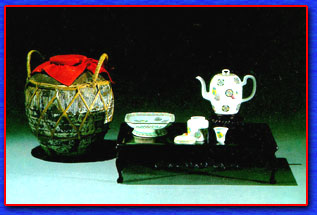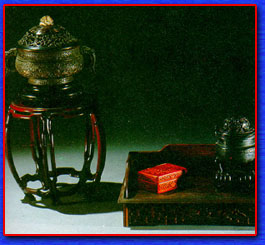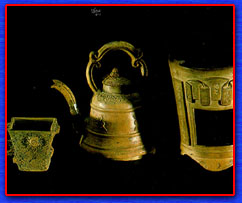
![]()


![]()

![]()

Wine and Flower |
|
| "Wine and flowers," which combined the drinking of wine with the enjoyment of flower arrangements, originated during the Tang Dynasty, and Lo Chiu makes mention of "fine wine" in his nine principles. In "wine and flowers" one gazed directly at the flower composition while imbibing a cup of wine, a practice which was believed to heighten one's aesthetic appreciation of the object at hand. As the ancients put it, "Flower compositions are at their best when the buds are in half bloom, and wine its most delicious when properly aged." The "art of the inebriated," as it was sometimes called, over the years was refined into an almost metaphysical activity in which one left behind the self and the material, became one with the universe, and experienced a surge in his creative and literary powers. '"Wine and flowers" remained a popular pastime until the Sung Dynasty, and was a favorite activity at dinners and banquetes. The attraction which it held for file people of old is perhaps best summed up in these lines from Ouyang Hsiu's poem: "From deep red to white, each flower has its own rank and order. Would that I could spend every season with a cup of wine in hand and lovely blossoms blooming before me." And the escapades of this tipsy poet, reputed to have crafted one-hundred exquisite flower compositions himself, became part of the rich tradition surrounding the ancient art of floral arrangement. |
![]()

Incense and Flowers |
|
| Han Hsi-tsai of the Five Dynasties era was the first flower arranger known for the practice of burning incense while viewing his flower compositions. According to Han, "burning incense while gazing at flowers provides an ineffable sense of charm and well-being." And what was later to become known as the "five harmonies" - matching incense aromas with the odors of specific flowers originated with this gentleman. "Incense and flowers" grew in popularity throughout the Sung and Yuan Dynasties. Although the Ming era saw a movement led by Yuan Hung-tao in opposition to this practice on the ground that it was harmful to flowers throughout the eriod there was no lack of adherents. In fact, the Shih Nu Tien Tsui(士女殿最)makes mention of as many as sixteen different flower-incense combinations, all designed to enhance and accentuate the natural fragrance of the flowers. Indeed, pairing each flower from nature's limitless garden with its own inimitable incense odor became one of the more fascinating aspects of traditional flower arrangement and lent additional color and charm to this age-old art. |
![]()

Tea and Flowers |
| More than just attempting to please the senses, flower arrangers often
intended their compositions to embody certain ideals or to convey specific
messages. Common hemes highlighted dissatisfaction with the social ills
of the day, provided a refuge from such problems, or sometimes offered
a suggestion as to their ultimate solution. As this "thought-intensive"
method of flower arrangement grew in importance after the Ming Dynasty,
it gradually merged with the custom of tea drinking and found its highest
expression in intellectual(理©尷寣^and tea flower(茶花)compositions.
Yuan Hung-tao in his History, of the Vase(瓶史)ranked the activities which accompanied the appreciation of flower arrangements in the following order of desirability: "tea drinking, first; conversation, second; wine drinking, last." In contrast to wine and flowers tea and flowers was a more practical activity requiring knowledge, skill, and perceptiveness, a thinking man's instead of a drinking man's art. As painting from earlier times reveal, the practice of sipping tea while viewing flowers was already quite popular even before the Sung Dynasty. However, it remained until the Sung for the ritual of tea drinking to be grated formal recognition, along with flower arrangement, incense burning, and scroll mounting, as one of the "four arts." And the relationship between serving tea and flower appreciation grew even more intricate and elaborate during the ensuing Ming Dynasty.
|
[preface] [
styles] [religious] [palace]
[literati] [folk]
[9 pricniples] [significance] [preveration]
[vessels] [appreciatin]
[Pavilion of Taiwan,
R.O.c] [Cultures]
[Council For Cultural
Affairs]